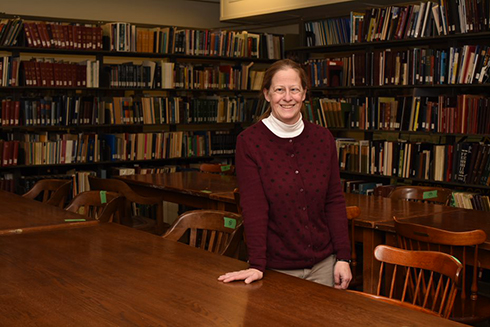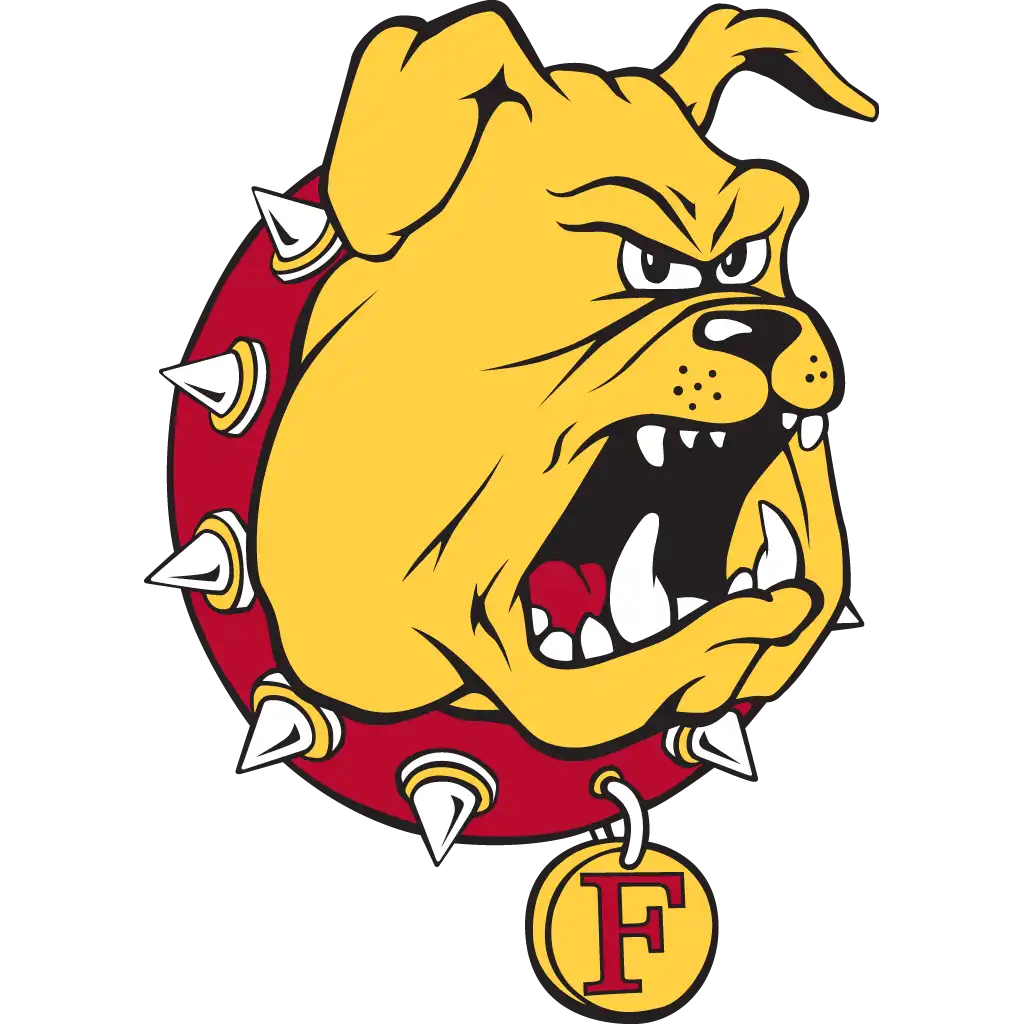Archivist and Special Collections Librarian
by John Smith - Dec. 10, 2021
 The adage “everything old is new again” may have some credence for Ferris State University’s
Archives. Campus changes in the 138th year of operations mean Archivist and Special
Collections Librarian Melinda Isler enters another phase of packing materials and
relocating on campus in the name of protecting and preserving details of the institution’s
legacy.
The adage “everything old is new again” may have some credence for Ferris State University’s
Archives. Campus changes in the 138th year of operations mean Archivist and Special
Collections Librarian Melinda Isler enters another phase of packing materials and
relocating on campus in the name of protecting and preserving details of the institution’s
legacy.
Isler is entering her 20th year of employment overseeing the Ferris Archives. She
started at a point where the Ferris Library for Information, Technology and Education
(FLITE) was new, and the storehouse of materials was not on the campus, proper.
“I had come to Ferris from Cincinnati, where I was an Assistant Archivist with the
Jacob Rader Marcus Center of the American Jewish Archives,” Isler said. “As I considered
the position, I could see that my predecessor, Larry Martin, had done a great job
with the materials. I wanted to stretch my wings professionally and explained during
my interviews that I would seek to make those materials more accessible, addressable
and available.”
Isler said she began her role with a couple of obstacles in place: Martin was not
available to offer consultation on matters that included the status of those offsite
materials.
“It certainly helped to have Mary Eustace Gallagher join me on staff, as she was a
legacy employee with more than 30 years of service to Ferris,” Isler said. “It was
an asset to have someone who has lived the history of the university alongside, as
a second-generation Ferris employee. She also had extensive library experience, so
we took on the considerable task of handling the offsite materials, with plans to
restore them to the main campus.”
With the former Timme Library converted into Ferris’ center for administrative operations,
the stuff of university history was stored in facilities on the east side of town.
Isler said this interim period of separated service became more difficult for a time,
as the Maple Street Bridge was out of service.
“There were times that a trip to bring back materials would take 45 minutes,” Isler
said. “I received great assistance when our base of operations was in FLITE, as library
staff could help me determine many things since my direct predecessor was not available
to offer consultation.”
That arrangement of offsite storage continued for several years, but conversations
took place and saw the materials and administration reassembled in the Alumni Building
in 2008.
“Over the years, some donations made by alumni or their families have produced surprising
finds,” Isler said. “There was a Ferris yearbook submitted, which had a program for
the 1894 dedication ceremony for what we knew as ‘Old Main’ there, within its pages.
Another contact brought us an excused absence slip signed by Woodbridge N. Ferris
for a woman who was studying shorthand. Administrative newsletters from Mr. Ferris
are another example of materials that turn up and arrive as a gift for the archives.
The multi-generational connections we make are not always face-to-face, but I accept
all offers because you can never presume what unique and important item from Ferris’
past may be part of their gift.”
Some ephemera and objects of interest from the Ferris Institute, Ferris State College
and other institutional eras are on display for today’s students and visitors to examine.
Isler said this group of items, placed on the third floor of the Timme Center for
Student Success, serves to pique the interest of prospective and current students.
“I have worked with the History Task Force to determine the most appropriate historical
items to display there,” Isler said. “We are happy to have that spot on campus, as
prospective and current Ferris students are brought there, so they have an idea of
the significant points of history that are still theirs to examine and consider.”
Isler said there was a surge of outreach and offerings made to the University Archives
when many other aspects of the institution had gone quiet in the early months of the
COVID-19 pandemic in 2020.
“I did not have student workers to assist my efforts in contacting those who had reached
out, to say they were cleaning out an attic or some other area and came upon some
item from Ferris’ past,” Isler said. “It was great to see those materials. One detriment
the pandemic produced was delaying a visit from the last surviving child of the last
person hired to join the Ferris Institute staff by Woodbridge Ferris. He was able
to come to campus this summer. It was thrilling to view an image of his father from
1950, though the photograph was a shot of him observing the fire that destroyed ‘Old
Main.’ We also have his father’s wool coat, which he was wearing in the February chill
that night. ‘Dad’ was a little bit bigger.”
Though there has been more than a decade of synergy for the University Archives, with
staff and historical items together in the Alumni Building, there will be a period
of transition, as the facility sees an upgrade, to serve as the home for Information
Technology Services. Isler said her office space returns to FLITE once again.
“The retrofit for the Alumni Building will be bid out in December,” Isler said. “Once
that begins, we will be happy to receive donations, but they should be directed to
our temporary space, on the fourth floor of FLITE.”
The temporary base for the Archives will be a conference room, with some records heading
to work cubicles in that vicinity, and the university’s small book collection is another
storehouse for some of those materials.
“We have determined which items head to FLITE for access during the renovation, while
the rest of our stores will be kept in an available space in West Campus,” Isler said.
“We intend to continue our services to the campus and handle inquiries as they come
to us. We will need to have fair notice from the campus community, if they are seeking
archival materials, for what will be a year’s time, to complete the upgrades in the
Alumni Building.”
Isler said online finding aids can be a source of success, but many of the written
records and photographic images from Ferris’ history are currently, and will remain
printed materials.
“Some exchanges that are along the lines of people who wonder, ‘Was my grandfather
a Ferris student in 1920’ can be resolved by checking yearbooks, to see if the dates
in their family legends match up with our records,” Isler said. “I feel it is our
duty to give those inquiries all the information that we can.”
Isler is comfortable in the relative seclusion the Archives present, among the large
photos of Homecoming Grand Marshals, athletic teams and other campus notables, but
often shares that space with student workers. Melinda said serving as an FSU Seminar
instructor allows her to meet and identify prospects since the Archives are a different
opportunity compared to other student jobs.
“They come to understand and appreciate that the job is challenging, with unique requirements,
compared to other work on campus,” Isler said. “They have to do some lifting and sifting
of collections to get to a requested item. It is not all drudgery, though. They learn
from their searches, even if it is just that a family recollection may have been off
by a few years when we go through yearbooks to verify that descendant was a student
at Ferris in time.”
Being a student employee in the University Archives has its advantages, compared to
other campus worksites, according to Isler.
“It doesn’t hurt that we are on an 8 a.m. to 5 p.m., Monday through Friday schedule,”
Isler said. “There are students who heard about the Archives in their FSUS class,
who became members of our staff. I have had students that begin with us as underclassmen
stay on, as they attend Pharmacy school, here.”
Being around the university’s items of considerable age still provides the students
working in the Archives opportunities to develop skills that will serve them as they
begin their professional lives.
“I make sure that student workers are front and center when we offer findings to off-campus
contacts, seeking information about their predecessors,” Isler said. “I also make
sure that they get familiar with new and unique donations to the Archives, which includes
having them record those donations. I am happy to help them build the experiences
that come from working with us, which includes selecting items for the public display
in the Timme Building.”
John Smith is a communications specialist for News Services and Social Media in University
Advancement and Marketing.

